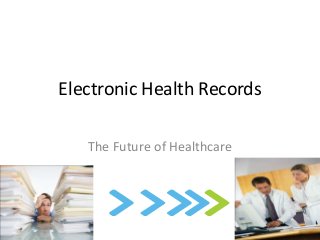
Id#2013010022 powerpoint lab1
- 1. Electronic Health Records The Future of Healthcare
- 2. What is an Electronic Health Record (EHR) • A computer system of individual patient information. Intended to replace ‘paper’ records or charting.
- 3. What does an EHR contain? • Demographics ( name, age, address and so on) • Insurance Information • Personal and family healthcare history • Allergies, if any • Current and long-term medical issues/disorders • treatments; including medications, labs and imaging results (past& present) • Physical examination ( specific findings)
- 4. How does EHR systems benefit you as a patient • Patients can actively participate in their care, via the patient portal on the clinic’s website; • New patients can log onto the website to request an appointment to visit the doctor • Existing patients can use portal to update personal demographics and insurance information • Patients can also log onto the website to obtain instructions in preparation for an imagine procedure, like drinking plenty of fluids before an ultrasound and so on.
- 5. Other General Benefits of EHR • Improves patient safety: lowers the risk for medication error due to illegible handwritings. • Reduces the risk for misplacing pertinent information • Enhances quality of care by the use of evidence-based- practices guidelines that enable healthcare workers to make more informed, beneficial decisions about patient care. • Is more efficient and cost effective, as it eliminates risk for repeating medical investigations, for example, and lowers data storage and retrieval costs.
- 6. The Barriers of EHR • May lack standards. • Having to train all staff on the software can be time consuming and costly. • Program initiation and maintenance can be costly. • Security of medical records is also a major concern.
- 7. The Future of EHR • In collaboration with the internet and modern technologies, EHR’s are expected to be rapidly available not just to medical personnel, but also the patient and third party entities such as insurance companies. Therefore helping to provide quality patient care.
- 8. Conclusion Electronic health records, also known as computer-based records (CPR); electronic medical records (EMR) or personal health records ( PHR) is an effective, “paper-free” tool, that unites all dimensions of the healthcare team, to help implement a safe, quality standard of care to the patient/client.